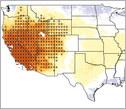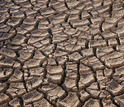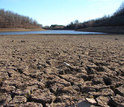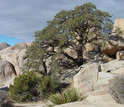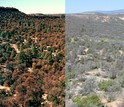News Release 16-011
Southwest sliding into a new normal: drier conditions
Weather patterns that bring rain becoming less frequent
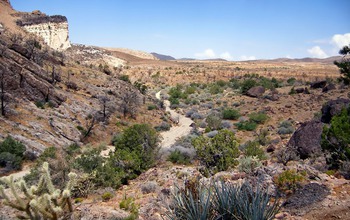
The southwestern U.S., much of which is arid, is becoming more dry as weather patterns shift.
February 4, 2016
This material is available primarily for archival purposes. Telephone numbers or other contact information may be out of date; please see current contact information at media contacts.
Find related stories on NSF's geosciences risk and resilience interest area at this link.
The weather patterns that typically bring moisture to the Southwest are becoming more rare, an indication that the region is sliding into the drier climate state predicted by global models, according to a new study.
"A normal year in the Southwest is now drier than it once was," said Andreas Prein, a researcher at the National Center for Atmospheric Research (NCAR) in Boulder, Colorado, who led the study. "If you have a drought nowadays, it will be more severe because our base state is drier."
Climate models generally agree that human-caused climate change will push the southwestern United States to become drier. And in recent years, the region has been stricken by drought. But linking model predictions to changes on the ground is challenging.
In the new study -- published online today in the journal Geophysical Research Letters, a publication of the American Geophysical Union -- researchers grapple with the cause of current drying in the Southwest to better understand how it might be connected to a warming climate.
Subtle shift yields dramatic effect
For the study, the researchers analyzed 35 years' worth of data to identify common weather patterns -- arrangements of high and low pressure systems that determine where it's likely to be sunny and clear or cloudy and wet.
They identified a dozen patterns that are usual for the weather activity in the contiguous U.S., then looked to see whether those patterns were becoming more or less frequent.
"The weather types that are becoming more rare are the ones that bring a lot of rain to the southwestern United States," Prein said. "Because only a few weather patterns bring precipitation to the Southwest, those changes have a dramatic impact."
The Southwest is especially vulnerable to any additional drying. The region, already the most arid in the country, is home to a quickly growing population that is putting tremendous stress on its limited water resources.
"Prolonged drought has many adverse effects, so understanding regional precipitation trends is vital for the well-being of society," says Anjuli Bamzai, program director in the National Science Foundation (NSF) Division of Atmospheric and Geospace Sciences, which funded the research. "These researchers demonstrate that subtle shifts in large-scale weather patterns over the past three decades or so have been the dominant factor in precipitation trends in the southwestern United States."
The study also found an opposite, though smaller, effect in the Northeast, where some of the weather patterns that typically bring moisture to the region are increasing.
"Understanding how changing weather pattern frequencies may impact total precipitation across the U.S. is particularly relevant to water resource managers as they contend with issues such as droughts and floods, and plan future infrastructure to store and disperse water," said NCAR scientist Mari Tye, a co-author of the study.
The climate connection
The three patterns that tend to bring the most wet weather to the Southwest all involve low pressure centered in the North Pacific just off the coast of Washington, typically during the winter.
Between 1979 and 2014, such low-pressure systems formed less and less often. The associated persistent high pressure in that area over recent years is a main driver of the devastating California drought.
This shift toward higher pressure in the North Pacific is consistent with climate model runs, which predict that a belt of higher average pressure that now sits closer to the equator will move north.
This high-pressure belt is created as air that rises over the equator moves poleward, then descends back toward the surface. The sinking air causes generally drier conditions over the region and inhibits the development of rain-producing systems.
Many of the world's deserts, including the Sahara, are found in such regions of sinking air, which typically lie around 30 degrees latitude on either side of the equator.
Climate models project that these zones will move further poleward. The result is a generally drier Southwest.
While climate change is a plausible explanation for the change in frequency, the authors caution that the study does not prove a connection.
To examine this potential connection further, they are studying climate model data for evidence of similar changes in future weather pattern frequencies.
"As temperatures increase, the ground becomes drier and the transition into drought happens more rapidly," said NCAR scientist Greg Holland, a co-author of the study. "In the Southwest the decreased frequency of rainfall events has further extended the period and intensity of these droughts."
Other co-authors of the study include NCAR scientists Roy Rasmussen and Martyn Clark.
In addition to NSF, the study was funded by the Research Partnership to Secure Energy for America.
-NSF-
-
Weather systems that usually bring moisture to the U.S. Southwest are forming less often.
Credit and Larger Version -
Cracked, dry earth is common throughout the Southwest's drying waterways.
Credit and Larger Version -
The drought that crippled California is by some measures the worst in the state's history.
Credit and Larger Version -
Pinyon trees throughout the southwestern U.S. go through die-offs after droughts.
Credit and Larger Version -
Evergreen pinyon pines turn brown from drought (left). A year later, pine needles are gone (right).
Credit and Larger Version
Media Contacts
Cheryl Dybas, NSF, (703) 292-7734, email: cdybas@nsf.gov
David Hosansky, NCAR, (303) 497-8611, email: hosansky@ucar.edu
Related Websites
NSF Grant: Developing a Next-Generation Approach to Regional Climate Prediction at High Resolution: http://www.nsf.gov/awardsearch/showAward?AWD_ID=1048829&HistoricalAwards=false
The U.S. National Science Foundation propels the nation forward by advancing fundamental research in all fields of science and engineering. NSF supports research and people by providing facilities, instruments and funding to support their ingenuity and sustain the U.S. as a global leader in research and innovation. With a fiscal year 2023 budget of $9.5 billion, NSF funds reach all 50 states through grants to nearly 2,000 colleges, universities and institutions. Each year, NSF receives more than 40,000 competitive proposals and makes about 11,000 new awards. Those awards include support for cooperative research with industry, Arctic and Antarctic research and operations, and U.S. participation in international scientific efforts.
Connect with us online
NSF website: nsf.gov
NSF News: nsf.gov/news
For News Media: nsf.gov/news/newsroom
Statistics: nsf.gov/statistics/
Awards database: nsf.gov/awardsearch/
Follow us on social
Twitter: twitter.com/NSF
Facebook: facebook.com/US.NSF
Instagram: instagram.com/nsfgov

